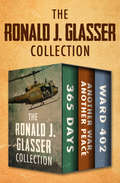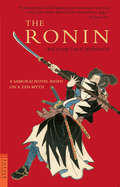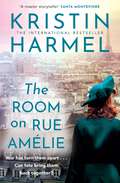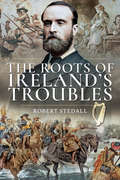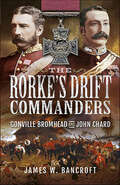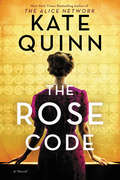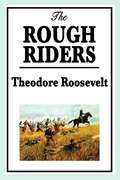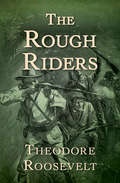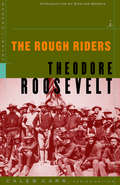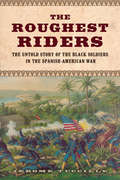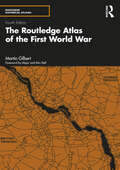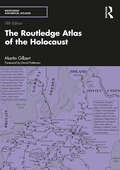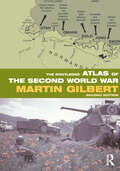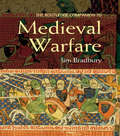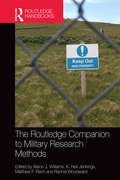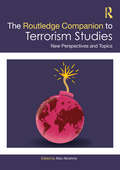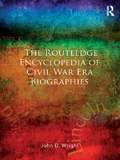- Table View
- List View
The Ronald J. Glasser Collection: 365 Days; Another War, Another Peace; and Ward 402
by Ronald J. GlasserAn army doctor’s classic Vietnam War memoir—a National Book Award Finalist and “a book of great emotional impact”—plus two powerful novels (The New York Times). Published in 1971 with the Vietnam War still raging, Ronald Glasser’s unflinching memoir of one doctor’s experience with the human cost of the devastating conflict was hailed by William Styron as “a moving account about tremendous courage and often immeasurable suffering . . . [A] valuable and redemptive work.” 365 Days quickly became a powerful anti-war statement of the time that still resonates today, selling over two hundred thousand copies. Turning to fiction, Glasser continued to draw on his own experience as a doctor in the Vietnam War and as an intern in a pediatric ward to craft novels of gripping drama and heartfelt poignancy. 365 Days: In 1968, as a serviceman in the Vietnam War, Ronald Glasser, a pediatrician, was sent to Japan to work at the US Army hospital tending to children of officers and government officials. But he was soon caught up in the waves of casualties that poured in from every Vietnam front. In 365 Days, Glasser reveals a candid and shocking account of that harrowing experience, giving voice to the wounded, the maimed, the dead, with unflinching candor and compassionate humanity. “The most convincing, most moving account I have yet to read about what it was like to be an American soldier in Vietnam.” —Newsweek Another War, Another Peace: Assigned to Southeast Asia during the Vietnam War, an idealistic young doctor forms an unlikely bond with his driver, a battle-hardened soldier, as they struggle to bring medical aid to Vietnamese villagers. “The author of the remarkable classic 365 Days has in this small novel written with such power about a young American doctor in the war zone that surely he has added another memorable book to the literature of those ghastly years.” —Gloria Emerson, author of Winners & Losers Ward 402: In this gripping, authentic, and impassioned novel, an intern on pediatric Ward 402 fights to save an eleven-year-old girl with advanced leukemia, which her parents believe to be terminal. “[Dr. Glasser] can describe a medical emergency in a way that makes the entire scene spring to life. . . . This is good and exciting writing.” —The New York Times Book Review
The Ronin
by William Dale JenningsThe violence of twelfth-century Japan explodes in this half-legendary, half-true story of a violent ronin who becomes a folk hero. Told with humor and irony, The Ronin ranges from the pleasantly colloquial to the brutally satiric. This brief tale will shock, confound and ultimately inspire readers.
The Room of White Fire
by T. Jefferson ParkerFor fans of Michael Connelly and C. J. Box: a stirring thriller from New York Times bestseller and award winner T. Jefferson Parker. In The Room of White Fire, a P.I. must hunt down a soldier who is damaged by war, dangerous, and on the run. A young soldier escaped from a mental institution. A P.I. carrying his own wounds hired to track that soldier down. A race against the clock to bring the soldier home before he reveals the secret that haunts him. Roland Ford—once a cop, then a marine, now a private investigator—is good at finding people. But when he’s asked to locate Air Force veteran Clay Hickman, he realizes he’s been drawn into something deep and dark. He knows war, having served as a Marine in first Fallujah; he also knows personal pain, as only two years have passed since his wife, Justine, died. What he doesn’t know is why a shroud of secrecy hangs over the disappearance of Clay Hickman—and why he’s getting a different story from everyone involved. To begin with, there’s Sequoia, the teenage woman who helped Clay escape; she’s smart enough to fend off Ford’s questions but impetuous enough to be on the run with an armed man. Then there’s Paige Hulet, Clay’s doctor, who clearly cares deeply for his welfare but is impossible to read, even as she inspires in Ford the first desire he has felt since his wife’s death. And there’s Briggs Spencer, the proprietor of the mental institution who is as enigmatic as he is brash, and ambitious to the point of being ruthless. What could Clay possibly know to make this search so desperate? What began as just a job becomes a life-or-death obsession for Ford, pitting him against immensely powerful and treacherous people and forcing him to contend with chilling questions about truth, justice, and the American way.
The Room on Rue Amelie
by Kristin HarmelA moving and entrancing novel set in Paris during World War II about an American woman, a dashing pilot, and a young Jewish girl whose fates unexpectedly entwine—perfect for the fans of Kristen Hannah&’s The Nightingale and Martha Hall Kelly&’s Lilac Girls, this is &“an emotional, heart-breaking, inspiring tribute to the strength of the human spirit and the enduring power of love&” (Mariah Stewart, New York Times bestselling author).When Ruby first marries the dashing Frenchman she meets in a coffee shop, she pictures a life strolling arm in arm along French boulevards, awash in the golden afternoon light. But it&’s 1938, and war is looming on the horizon. Unfortunately, her marriage soon grows cold and bitter, her husband Marcel, distant and secretive—all while the Germans flood into Paris, their sinister swastika flags waving in the breeze. When Marcel is killed, Ruby discovers the secret he&’d been hiding—he was a member of the French resistance—and now she is determined to take his place. She becomes involved in hiding Allied soldiers—including a charming RAF pilot—who have landed in enemy territory. But her skills are ultimately put to the test when she begins concealing her twelve-year-old Jewish neighbor, Charlotte, whose family was rounded up by the Gestapo. Ruby and Charlotte become a little family, but as the German net grows tighter around Paris, and the Americans debate entering the combat, the danger increases. No one is safe. &“Set against all the danger and drama of WWII Paris, this heartfelt novel will keep you turning the pages until the very last word&” (Mary Alice Monroe, New York Times bestselling author).
The Room on Rue Amelie: A powerful novel of fate, resistance, and family by a New York Times bestselling author
by Kristin HarmelA powerful novel of fate, resistance, and family by an international bestselling author.War has torn their love apart . . . can fate bring them back together?When newlywed Ruby Henderson Benoit arrives in Paris in 1939 with her French husband Marcel, she imagines strolling arm in arm along the grand boulevards, awash in the golden afternoon light. But war is looming on the horizon, and as France falls to the Nazis, her marriage begins to splinter, too.Charlotte Dacher is eleven when the Germans roll into the French capital, their sinister swastika flags snapping in the breeze. After the Jewish restrictions take effect and Jews are ordered to wear the yellow star, Charlotte can't imagine things getting much worse. But then the mass deportations begin, and her life is ripped forever apart.'Kristin Harmel is firmly in the top echelon of WW2 storytellers' HEATHER MORRIS'A master storyteller' SANTA MONTEFIOREPRAISE FOR THE PARIS DAUGHTER:'An unmissable reading treat' Lancashire Evening Post'Beautifully written and emotionally charged . . . impossible to put down' HAZEL GAYNOR'The Paris Daughter tore up my heart and put it back together again' MARTHA HALL KELLY'A gorgeous, gut-wrenching read!' KATE QUINN
The Root and the Flower
by Penelope Fitzgerald L. H. MyersSet in the war-torn world of Mughal India and first published in the gathering darkness of the 1930s, The Root and the Flower is an epic story of intrigue, murder, and romance; of Tantric abandonment and Buddhist renunciation; of emotional delirium and spiritual adventure. The cast of characters includes Hari, a reckless and passionate warrior; Sita, in love with both Hari and her husband Amar, a prince who wishes to forsake the world but is increasingly drawn into a bloody political struggle; and Sita and Amar's son Jali, whose precocious encounters with sex and violence threaten him with madness.At once a dream of India and a vision of a world riven by political, ethnic, and religious conflicts, The Root and the Flower is a work of great range and singular poetic beauty. It is, in Penelope Fitzgerald's words, a "strange masterpiece," and one of the unsung glories of modern literature.
The Roots of Ireland's Troubles
by Robert StedallThe author of Elizabeth I&’s Secret Lover&“places Ireland into a much wider context and takes it beyond the simplistic Catholic v Protestant dichotomy&” (The British Empire Blog). Over the course of three decades in the late twentieth century, Northern Ireland was embroiled in the Troubles, a conflict characterized by the violent and bitter struggle between nationalists and unionists. Many books in recent years have attempted to make sense of the Troubles. Primarily political and nationalistic, it also had a sectarian dimension. Undeniably it was fueled by historical events, and yet most only look so far back as the 1916 uprising. In The Roots of Ireland&’s Troubles, Robert Stedall argues that we need to take a longer historical view to truly understand the complex factors at play in Ireland&’s history that ultimately led to the Troubles. Comprehensive in its approach, it ranges from Plantagenet intervention among the warring Gaelic chieftains, to Cromwell&’s restoration of British rule following the English Civil War and William Pitt&’s resignation over the Irish Catholic&’s Emancipation question. Inextricably linked with the history of Britain, Stedall guides the reader through Ireland&’s turbulent but rich history. To understand the causes behind the twentieth-century conflict, which continues to resonate today, we must look to the long arc of history in order to truly understand the historical roots of a nation&’s conflict. &“A very readable and direct account of the complex issues at the heart of Anglo-Irish relationships since the Reformation . . . a totally absorbing book.&” —Michael McCarthy, Battlefield Guide
The Rorke's Drift Commanders: Gonville Bromhead and John Chard
by James W. BancroftLieutenant Gonville Bromhead and Lieutenant John Chard had fame thrust upon them, as did the place known as Rorke’s Drift, which before 1879 was an unknown homestead situated in the middle of the South African veld. Although both men came from families whose various members were highly distinguished for their military service and for their service to the church, they became reluctant heroes after being awarded Britain’s highest decoration for valor, the Victoria Cross. During the Anglo-Zulu War in 1879, a British invasion force was massacred at iSandlwana, after which a wing of the Zulu army about 3,000 strong attacked the outpost at Rorke’s Drift. Lieutenants Bromhead and Chard commanded the post, and after supervising the construction of barricades they led their men in defensive actions throughout the night until the Zulus lost heart and returned to their kraals. For their gallantry ‘under most trying circumstances’, both Bromhead and Chard, along with nine of their comrades, were subsequently awarded the Victoria Cross. In 1964 the defence of Rorke’s Drift was brought back to public attention with the producing of the epic motion picture Zulu! In this film, Chard was portrayed by Sir Stanley Baker, while Bromhead provided Sir Michael Caine with his first starring role. Bromhead and Chard epitomised the way of life of Victorian officers, with the exception that fate put them at Rorke’s Drift. They became major players in a battle which continues to excite interest and cause debate, and is unlikely ever to be forgotten.
The Rose Code: A Novel
by Kate Quinn“The reigning queen of historical fiction” -- Fiona Davis, New York Times bestselling author of The Lions of Fifth Avenue The New York Times and USA Today bestselling author of The Huntress and The Alice Network returns with another heart-stopping World War II story of three female code breakers at Bletchley Park and the spy they must root out after the war is over.1940. As England prepares to fight the Nazis, three very different women answer the call to mysterious country estate Bletchley Park, where the best minds in Britain train to break German military codes. Vivacious debutante Osla is the girl who has everything—beauty, wealth, and the dashing Prince Philip of Greece sending her roses—but she burns to prove herself as more than a society girl, and puts her fluent German to use as a translator of decoded enemy secrets. Imperious self-made Mab, product of east-end London poverty, works the legendary codebreaking machines as she conceals old wounds and looks for a socially advantageous husband. Both Osla and Mab are quick to see the potential in local village spinster Beth, whose shyness conceals a brilliant facility with puzzles, and soon Beth spreads her wings as one of the Park’s few female cryptanalysts. But war, loss, and the impossible pressure of secrecy will tear the three apart. 1947. As the royal wedding of Princess Elizabeth and Prince Philip whips post-war Britain into a fever, three friends-turned-enemies are reunited by a mysterious encrypted letter--the key to which lies buried in the long-ago betrayal that destroyed their friendship and left one of them confined to an asylum. A mysterious traitor has emerged from the shadows of their Bletchley Park past, and now Osla, Mab, and Beth must resurrect their old alliance and crack one last code together. But each petal they remove from the rose code brings danger--and their true enemy--closer...
The Rose Queen: The heartwarming romance from the Sunday Times bestselling author
by Katie FlynnTHE #2 SUNDAY TIMES BESTSELLING SAGA FROM AUTHOR KATIE FLYNNWill love bloom in a new city?It is 1938, and Cadi is chosen to be Rose Queen in the annual Rose Fete. She's thrilled to be treated like royalty for the day. But deep down she's desperate to leave the Welsh mining community where she grew up.When war is declared, Cadi and her best friend Poppy see a chance to escape. Cadi leaves behind her parents and local boy Aled, whom she is meant to marry, for Liverpool.But city life does not bring the opportunities they had hoped for. Unable to join the forces, the girls are left looking for work in poverty-stricken Scotland Ward.They secure jobs in a local pub, and Cadi's blossoming relationship with a handsome dock worker deepens after he rescues her from a terrifying encounter.But when Aled unexpectedly appears dressed in RAF uniform Cadi finds her worlds colliding again. Now the Rose Queen must decide: who will become her King?_____________________________________________Why readers love Katie Flynn's heartwarming historical romances: 'Her characters feel like old friends!''Takes you on a journey of heartbreak and joy''Heartwarming romance''Impossible to put down'
The Rough Riders
by Theodore RooseveltAlong with Colonel Leonard Wood, Theodore Roosevelt instigated the founding of the 1st United States Volunteer Cavalry in 1898 at the beginning of the Spanish-American War. Nicknamed the Rough Riders by journalists, the Cavalry engaged in several battles. This is Roosevelt s best-selling account of one of the most fascinating regiments in American military history.
The Rough Riders
by Theodore RooseveltTheodore Roosevelt’s bestselling memoir chronicling the 1st United States Volunteer Cavalry and its victory at San Juan Hill in the Spanish-American War. Yearning to join the fight for Cuban independence in the Spanish–American War, Theodore Roosevelt and Col. Leonard Wood formed the 1st United States Volunteer Cavalry. They enlisted a motley crew from all walks of life, from cowboys and frontiersmen to Ivy League graduates. These 1,250 men became known as the Rough Riders. After training in San Antonio, Texas, they set out for the tropical jungles of Cuba. As they grappled with hunger, malaria, and occasional defeat, their many battles with the Spanish Army culminated in the death-defying charge to victory at San Juan Hill. Through it all, Roosevelt kept a pocket diary in which he made daily entries about his experiences and the men who fought beside him. Imbued with his trademark vigor and certainty of purpose, Roosevelt’s firsthand account of this historic campaign paints a vivid picture of the rugged, independent spirit that came to define American heroism. This ebook has been professionally proofread to ensure accuracy and readability on all devices.
The Rough Riders: An Account Of The Experiences And Hardships Of The American Rough Riders (Modern Library War)
by Theodore RooseveltIn 1898, as the Spanish-American War was escalating, Theodore Roosevelt assembled an improbable regiment of Ivy Leaguers, cowboys, Native Americans, African-Americans, and Western Territory land speculators. This group of men, which became known as the Rough Riders, trained for four weeks in the Texas desert and then set sail for Cuba. Over the course of the summer, Roosevelt's Rough Riders fought valiantly, and sometimes recklessly, in the Cuban foothills, incurring casualties at a far greater rate than the Spanish. Roosevelt kept a detailed diary from the time he left Washington until his triumphant return from Cuba later that year. The Rough Riders was published to instant acclaim in 1899.Robust in its style and mesmerizing in its account of battle, it is exhilarating, illuminating, and utterly essential reading for every armchair historian and at-home general. The books in the Modern Library War series have been chosen by series editor Caleb Carr according to the significance of their subject matter, their contribution to the field of military history, and their literary merit.
The Roughest Riders: The Untold Story of the Black Soldiers in the Spanish-American War
by Jerome TuccilleThe inspiring story of the first African American soldiers to serve during the postslavery eraMany have heard how Teddy Roosevelt and the Rough Riders charged up San Juan Hill during the Spanish-American War. But often forgotten in the great swamp of history is that Roosevelt's success was ensured by a dedicated corps of black soldiers--the so-called Buffalo Soldiers--who fought by Roosevelt's side during his legendary campaign. This book tells their story. They fought heroically and courageously, making Roosevelt's campaign a great success that added to the future president's legend as a great man of words and action. But most of all, they demonstrated their own military prowess, often in the face of incredible discrimination from their fellow soldiers and commanders, to secure their own place in American history.
The Routledge Atlas of the Arab-Israeli Conflict (Routledge Historical Atlases)
by Martin GilbertThe Routledge Atlas of the Arab-Israeli Conflict traces not only the tangled and bitter history of the Arab-Jewish struggle from the early twentieth century to the present, including the death of Yasser Arafat and recent proposals for compromise and co-operation, it also illustrates the current moves towards finding peace, and the efforts to bring the horrors of the fighting to an end through negotiation and agreed boundaries. In 227 maps, the complete history of the conflict is revealed, including: The Prelude and Background to the Conflict - from the presence of Jews in Palestine before the Arab conquest to the attitude of Britain to the Arabs and Jews since 1915 The Jewish National Home - from the early Jewish settlement and the Zionist plan for Palestine in 1919 to the involvement of the Arab world from 1945 to the present day The Intensification of the Conflict - from the Arab response to the United Nations partition plan of November 1947 to the declaration of Israeli independence in May 1948 The State of Israel - from the Israeli War of Independence and the Suez and Six Day Wars to the October War (the Yom Kippur War), the first and second intifadas, the suicide-bomb campaign, the Israel-Hezbollah War of 2006, Operation Cast lead against the Gaza Strip in 2009, the Gaza Flotilla of 2012 and Nakba Day 2011 The Moves to find Peace - from the first and second Camp David talks and the death of Arafat, to the continuing search for peace, including the Annapolis Conference, 2007, the work of the Quartet Emissary, Tony Blair 2007-2011, and the ongoing Palestinian search for statehood.
The Routledge Atlas of the Arab-Israeli Conflict: The Complete History Of The Struggle And The Efforts To Resolve It (Routledge Historical Atlases)
by Martin GilbertThe Routledge Atlas of the Arab-Israeli Conflict traces not only the tangled and bitter history of the Arab-Jewish struggle from the early twentieth century to the present, including the death of Yasser Arafat and recent proposals for compromise and co-operation, it also illustrates the current moves towards finding peace, and the efforts to bring the horrors of the fighting to an end through negotiation and agreed boundaries. In 227 maps, the complete history of the conflict is revealed, including: The Prelude and Background to the Conflict - from the presence of Jews in Palestine before the Arab conquest to the attitude of Britain to the Arabs and Jews since 1915 The Jewish National Home - from the early Jewish settlement and the Zionist plan for Palestine in 1919 to the involvement of the Arab world from 1945 to the present day The Intensification of the Conflict - from the Arab response to the United Nations partition plan of November 1947 to the declaration of Israeli independence in May 1948 The State of Israel - from the Israeli War of Independence and the Suez and Six Day Wars to the October War (the Yom Kippur War), the first and second intifadas, the suicide-bomb campaign, the Israel-Hezbollah War of 2006, Operation Cast lead against the Gaza Strip in 2009, the Gaza Flotilla of 2012 and Nakba Day 2011 The Moves to find Peace - from the first and second Camp David talks and the death of Arafat, to the continuing search for peace, including the Annapolis Conference, 2007, the work of the Quartet Emissary, Tony Blair 2007-2011, and the ongoing Palestinian search for statehood.
The Routledge Atlas of the First World War (Routledge Historical Atlases)
by Martin GilbertFrom its origins to its terrible legacy, the tortuous course of the Great War is vividly set out in a series of 196 fascinating maps. Together the maps form a comprehensive and compelling picture of the war that shattered Europe, and illustrate its military, social, political and economic aspects. Beginning with the tensions that already existed, the atlas covers: The early months of the war – from the German attack on Belgium and France, to the fierce fighting on the Western and Eastern Fronts The developing war in Europe and beyond – from the Somme and Verdun to Gallipoli and Mesopotamia, in the Near East and Africa, and in the Pacific The war at sea and in the air – from the Zeppelin and air raids to the naval battles, shipping losses and Atlantic convoys Life at the front – the trench system, living underground, the mud of Passchendaele, the French and Russian mutinies Technology and the intensifying war – from phosgene gas to submarines, tanks and aerial bombardment The home front – war supplies, munitions factories, the air defence of Britain, German food riots, the entry of the United States into the war, the Russian Revolution, and the collapse of the Austro-Hungarian and the Ottoman Empires The aftermath – the peace treaties and territorial changes, war debts, war deaths, and the new map of Europe along with the visual remembrance of the war, memorials that commemorate the tragedy. This new edition now includes an additional 23 of Martin Gilbert’s maps, across the whole period of the war, originally published across a range of publications, now gathered in this one volume for the first time.
The Routledge Atlas of the First World War: The Complete History (Routledge Historical Atlases)
by Martin GilbertFrom its origins to its terrible legacy, the tortuous course of the Great War is vividly set out in a series of 174 fascinating maps. Together the maps form a comprehensive and compelling picture of the war that shattered Europe, and illustrate its military, social, political and economic aspects. Beginning with the tensions that already existed, the atlas covers: the early months of the war: from the fall of Belgium to the fierce fighting at Ypres and Tannenberg: the developing war in Europe: from Gallipoli to the horrors of the Somme and Verdun life at the front: from living underground, the trench system and the mud of Passchendaele to the war graves technology and the new horrors: from phosgene gas attacks to submarines, tanks and mines the home fronts: from German food riots to the air defence of Britain, the Russian Revolution and the collapse of Austria-Hungary the aftermath: from war debts and war deaths to the new map of Europe. This third edition contains an entirely new section depicting the visual remembrance of the war; a fascinating visitors' guide to the memorials that commemorate the tragedy of the Somme.
The Routledge Atlas of the Holocaust (Routledge Historical Atlases)
by Martin GilbertThe graphic history of the Nazi attempt to destroy the Jews of Europe during the Second World War is illustrated in this series of 363 detailed maps. The maps, and the text and photographs that accompany them, powerfully depict the fate of the Jews between 1933 and 1945, while also setting the chronological story in the wider context of the war itself. The maps include: • Historical background – from the effects of anti-Jewish violence between 1880 and 1933 to the geography of the existing Jewish communities when the Nazi Party came to power • The beginning of the violence – from the destruction of the synagogues in November 1938 to Jewish migrations and deportations, the ghettos, and the establishment of the concentration camps and death camps throughout German-dominated Europe • The spread of Nazi rule – the fate of the Jews throughout Europe including Germany, Austria, Poland, Greece, Yugoslavia, Bulgaria, Russia, Denmark, Norway, France, Holland, Belgium, Italy, and the Baltic States • Jewish revolts and resistance – acts of armed resistance, fighting in the forests, individual acts of courage • Jews in hiding – escape routes, Christians who helped Jews • The death marches – the advance of the Allies and the liberation of the camps, the survivors, and the final death toll. This new edition now includes an additional 30 of Martin Gilbert’s maps, with many additional camp and ghetto maps, further illustrating the layout and organization of some of the most significant towns and cities affected by the Holocaust, especially useful to those visiting the sites.
The Routledge Atlas of the Holocaust: The Complete History (Routledge Historical Atlases)
by Martin GilbertThe graphic history of the Nazi attempt to destroy the Jews of Europe during the Second World War is illustrated in this series of 333 detailed maps. The maps, and the text and photographs that accompany them, powerfully depict the fate of the Jews between 1933 and 1945, while also setting the chronological story in the wider context of the war itself. The maps include: historical background – from the effects of anti-Jewish violence between 1880 and 1933 to the geography of the existing Jewish communities before the advent of the Nazis the beginning of the violence – from the destruction of the synagogues in November 1938 to Jewish migrations and deportations, the ghettos, and the establishment of the concentration camps and death camps throughout German-dominated Europe the spread of Nazi rule – the fate of the Jews throughout Europe including Germany, Austria, Poland, Greece, Yugoslavia, Bulgaria, Russia, Denmark, Norway, France, Holland, Belgium, Italy, and the Baltic States Jewish revolts and resistance – acts of armed resistance, fighting in the forests, individual acts of courage Jews in hiding – escape routes, Christians who helped Jews the death marches – the advance of the Allies and the liberation of the camps, the survivors, and the final death toll. This revised edition includes a new section which gives an insight into the layout and organization of some of the most significant places of the Holocaust, including Auschwitz, Treblinka and the Warsaw ghetto, maps that will be especially useful to those visiting the sites.
The Routledge Atlas of the Second World War (Routledge Historical Atlases)
by Martin GilbertIn The Routledge Atlas of the Second World War, Martin Gilbert graphically charts the war's political, military, economic and social history through 257 illuminating maps. The atlas covers all the major events from the German invasion of Poland in September 1939 to the defeat of Japan in August 1945. Focusing on the human - and inhuman - aspects of the war, The Routledge Atlas of the Second World War includes examination of: military, naval and air campaigns on all the war fronts the war on land, at sea and in the air the economic and social aspects of the war the global nature of the war, in armed combat and in suffering the impact of the war on civilians, both under occupation, and as deportees and refugees the aftermath of the war: post-war political and national boundaries; war graves; and the human cost of the war on every continent. This paperback edition includes several updates to existing maps, as well as ten new maps, specially drawn for this edition. The new maps include examinations of Japanese- American and African- American soldiers serving with the United States Army, British women special agents, Belgium at War, and the German occupation of the Channel Islands.
The Routledge Companion to Medieval Warfare (Routledge Companions to History)
by Jim BradburyThis comprehensive volume provides easily-accessible factual material on all major areas of warfare in the medieval west. The whole geographical area of medieval Europe, including eastern Europe, is covered, including essential elements from outside Europe such as Byzantine warfare, nomadic horde invasions and the Crusades. Progressing chronologically, the work is presented in themed, illustrated sections, with a narrative outline offering a brief introduction to the area. Within each chronological section, Jim Bradbury presents clear and informative pieces on battles, sieges, and generals. The author examines practical topics including: castle architecture, with examinations of specific castles ship building techniques improvements in armour specific weapons developments in areas such as arms and armour, fortifications, tactics and supply. Readable and engaging, this detailed provides students with an excellent collection of archaeological information and clear discussions of controversial issues.
The Routledge Companion to Military Research Methods
by Rachel Woodward Alison J. Williams Neil Jenkings Matthew F. RechThis new handbook is about the practices of conducting research on military issues. <P><P> As an edited collection, it brings together an extensive group of authors from a range of disciplinary perspectives whose chapters engage with the conceptual, practical and political questions raised when doing military research. The book considers a wide range of questions around research about, on and with military organisations, personnel and activities, from diverse starting-points across the social sciences, arts and humanities. <P><P> Each chapter in this volume: <li>Describes the nature of the military research topic under scrutiny and explains what research practices were undertaken and why. <li>Discusses the author's research activities, addressing the nature of their engagement with their subjects and explaining how the method or approach under scrutiny was distinctive because of the <li>military context or subject of the research. <li>Reflects on the author’s research experiences, and the specific, often unique, negotiations with the politics and practices of military institutions and military personnel before, during and after their research fieldwork. <P><P> The book provides a focussed overview of methodological approaches to critical studies of military personnel and institutions, and processes and practices of militarisation and militarism. In particular, it engages with the growth in qualitative approaches to military research, particularly research carried out on military topics outside military research institutions. The handbook provides the reader with a comprehensive guide to how critical military research is being undertaken by social scientists and humanities scholars today, and sets out suggestions for future approaches to military research. <P><P> This book will be of much interest to students of military studies, war and conflict studies, and research methods in general.
The Routledge Companion to Terrorism Studies: New Perspectives and Topics
by Max AbrahmsAlthough the literature on terrorism is vast, there are many holes in it. This book helps to fill these lacunae with entries from top terrorism scholars and counterterrorism practitioners in the world. Grouped thematically by terrorist actors, conflict zones, major attacks, terrorist behaviors, militant group dynamics, terrorist consequences, and counterterrorism approaches, the entries cover a range of topics fundamental to understanding the contemporary terrorism threat and approaches to combating it. Truly global in scope, the book is an ideal reference for anyone interested in these topics from a variety of disciplinary perspectives.Providing incisive analysis on timely topics related to terrorism and counterterrorism, this volume will be essential reading for students, scholars, and practitioners in security studies.
The Routledge Encyclopedia of Civil War Era Biographies
by John D WrightBehind the familiar names of the military and political leaders whose names we all know--Lincoln, Davis, Lee, Grant, Sherman, and Jackson, are the people whose lives and hard work defined the Civil War era: abolitionists, slaves, inventors, manufacturers, painters, lawyers, writers, spies, nurses, and preachers. These are the people who helped shape both the war and our ideas about it. The Routledge Encyclopedia of Civil War Era Biographies is a comprehensive collection of articles on roughly 900 individuals from the Civil War era, including people from both the years leading up to the war and the period of Reconstruction that came after. Also included are maps of key battles, a timeline that progresses from President Lincoln's election to the end of the war, and a list of innovations used or developed during the war.
